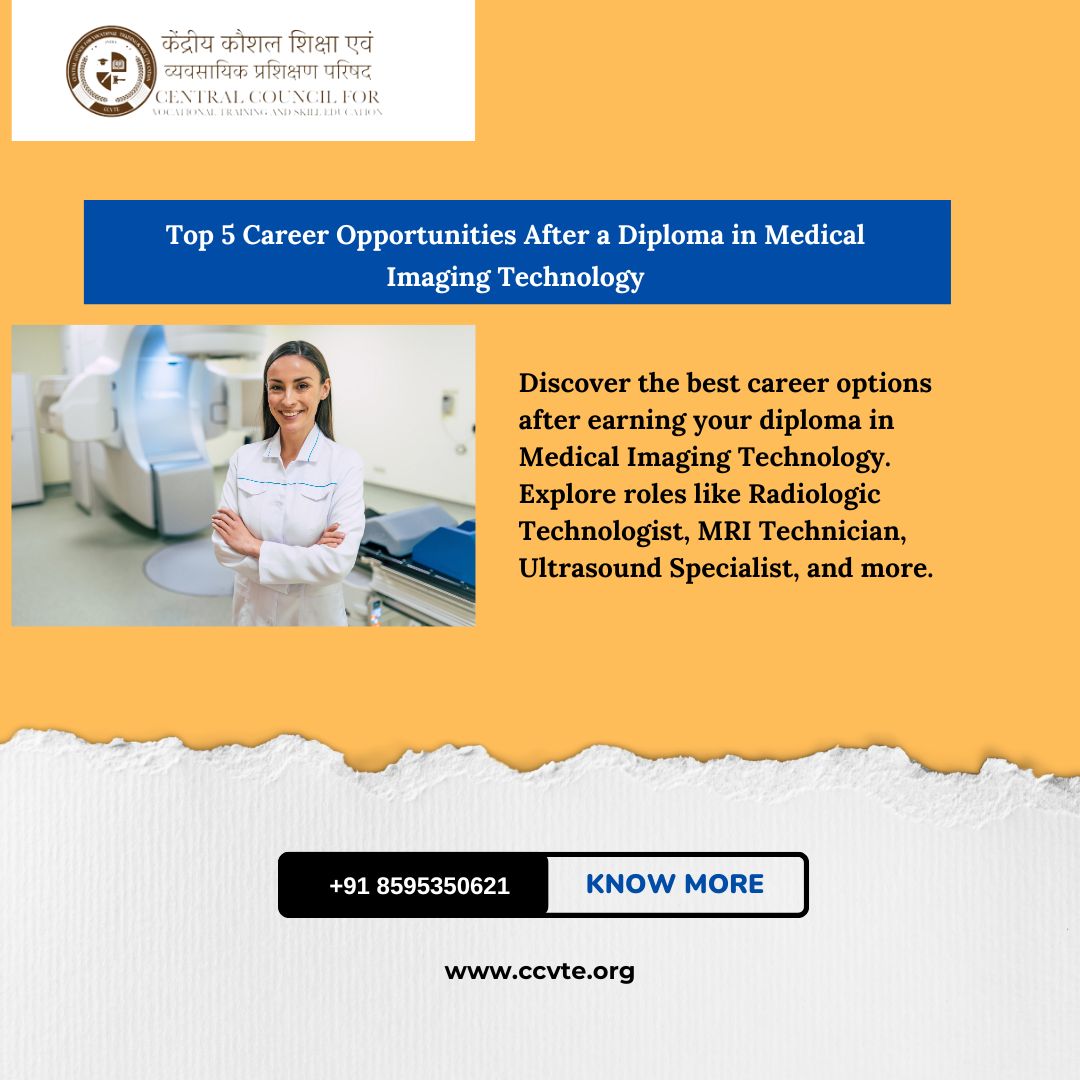Introduction
Medical imaging technology has transformed modern healthcare, playing a crucial role in diagnosing and treating a wide range of conditions. Whether it’s X-rays, CT scans, MRIs, or ultrasounds, these imaging techniques provide vital insights into the human body, helping doctors make informed decisions.
As demand for medical imaging grows, there is an increasing need for skilled professionals who can operate these technologies effectively. Pursuing a Diploma in Medical Imaging Technology can open the door to a rewarding career in this field.
What is a Diploma in Medical Imaging Technology?
A Diploma in Medical Imaging Technology is a specialized course designed to equip students with the technical and practical skills needed to operate advanced imaging equipment like X-ray machines, MRI scanners, and ultrasound devices. This program offers in-depth knowledge of the science behind imaging technologies, patient care, and safety protocols.
Why CCVTE Should Be Your Choice for This Course: CCVTE (Central College of Vocational Training and Education) has a strong reputation for offering top-tier healthcare education. With its emphasis on practical training and cutting-edge equipment, CCVTE ensures students are prepared to enter the workforce with confidence and competence. The institution’s focus on industry-relevant training sets it apart from other educational providers.
Eligibility Criteria for Diploma in Medical Imaging Technology
To enroll in a Diploma in Medical Imaging Technology program, candidates typically need to have completed high school (12th grade) with a focus on science subjects, such as physics, chemistry, and biology. A minimum grade requirement might apply, and some institutions may require entrance exams or interviews.
Other key requirements may include:
- Strong communication skills
- Aptitude for technical and medical subjects
- A genuine interest in healthcare and patient care
Course Curriculum and Subjects Covered
During the diploma program, students will be exposed to a range of subjects designed to provide a comprehensive understanding of medical imaging. Some core subjects include:
- Anatomy and Physiology: Understanding the human body and its functions is crucial for interpreting imaging results.
- Radiographic Imaging Techniques: Detailed study of X-rays, CT scans, and MRI technologies.
- Imaging Equipment and Safety: Learning how to operate and maintain imaging machines, ensuring patient and operator safety.
- Patient Care and Ethics: Training in patient communication and ethical considerations in healthcare.
- Specialized Imaging Techniques: Introduction to advanced imaging methods like nuclear medicine and interventional radiology.
Skills Developed During the Course
Students enrolled in the Diploma in Medical Imaging Technology will develop both technical and interpersonal skills. These include:
- Technical Skills: Proficiency in using imaging machines, understanding imaging software, and analyzing diagnostic results.
- Communication and Patient Care: Effective communication with patients and healthcare teams, as well as providing compassionate care to patients undergoing imaging procedures.
Duration and Modes of Study
The typical duration of the diploma course is 2-3 years, depending on the institution and whether it’s pursued full-time or part-time. Many schools, including CCVTE, offer flexible learning options such as online classes, which allow students to balance their studies with other responsibilities.
Why Choose CCVTE for a Diploma in Medical Imaging Technology?
CCVTE offers several key advantages for students pursuing a career in medical imaging:
- Reputation and Experience: CCVTE is known for its excellence in vocational healthcare education, with a track record of producing skilled graduates.
- State-of-the-Art Facilities: The institution invests in the latest imaging technologies, ensuring that students receive hands-on training.
- Industry-Relevant Curriculum: Courses are designed in collaboration with industry experts to align with current healthcare needs and trends.
Career Opportunities After Completing the Diploma
Graduates of the Diploma in Medical Imaging Technology program can explore various career paths, including:
- Diagnostic Radiographer: Using imaging technologies to assist in diagnosing medical conditions.
- MRI/CT Technician: Specializing in MRI and CT scans to capture detailed images of the body.
- Sonographer: Operating ultrasound machines to monitor pregnancies or diagnose conditions in internal organs.
- Research and Development: Working in R&D roles to develop new imaging technologies or improve existing ones.
Work Environment for Medical Imaging Technologists
Medical imaging professionals can work in a variety of environments, including:
- Hospitals: Providing diagnostic imaging services for patients in emergency and inpatient settings.
- Diagnostic Centers: Working in outpatient clinics that specialize in imaging procedures.
- Research Facilities: Contributing to medical research by providing imaging support for clinical studies.
Challenges and Rewards in the Medical Imaging Field
While the work of a medical imaging technologist can be demanding, with long hours and emotionally challenging situations, it is also highly rewarding. Technologists play a critical role in diagnosing diseases and improving patient outcomes, which provides a deep sense of satisfaction.
Continuing Education and Specializations
After completing the diploma, technologists can pursue advanced certifications or degrees in specialized fields like MRI, CT, or ultrasound. Continuing education is essential for staying updated on new technologies and improving job prospects.
Role of Technology in Advancing Medical Imaging
The medical imaging field is constantly evolving with advancements in digital imaging and artificial intelligence (AI). These innovations are improving diagnostic accuracy and enabling earlier detection of diseases, creating exciting opportunities for future technologists.
Accreditation and Licensing
Accreditation and licensing are crucial for career growth in this field. Most countries require medical imaging technologists to be licensed, and many employers prefer candidates who have graduated from accredited programs like those offered by CCVTE.
Conclusion
Pursuing a skill development programme is an excellent choice for individuals interested in healthcare and technology. With a strong foundation in both technical skills and patient care, graduates can look forward to fulfilling careers in various medical settings.
FAQs
- What is the duration of the Diploma in Medical Imaging Technology?
The course typically takes 2-3 years to complete, depending on the institution and mode of study. - Is this diploma enough to become a certified radiographer?
Yes, but certification requirements may vary depending on the country or region. - Can I work internationally with this diploma?
Yes, with the appropriate certification or licensing, graduates can work internationally.
